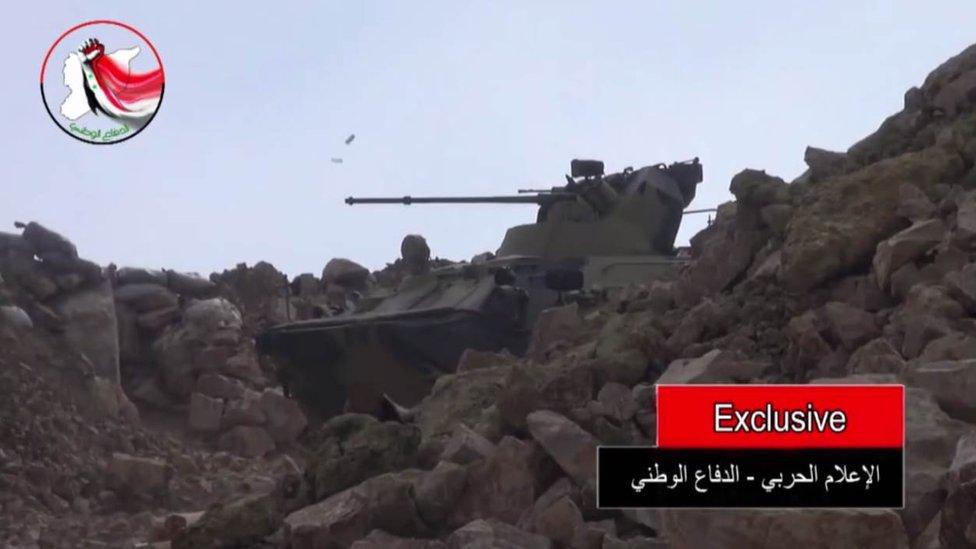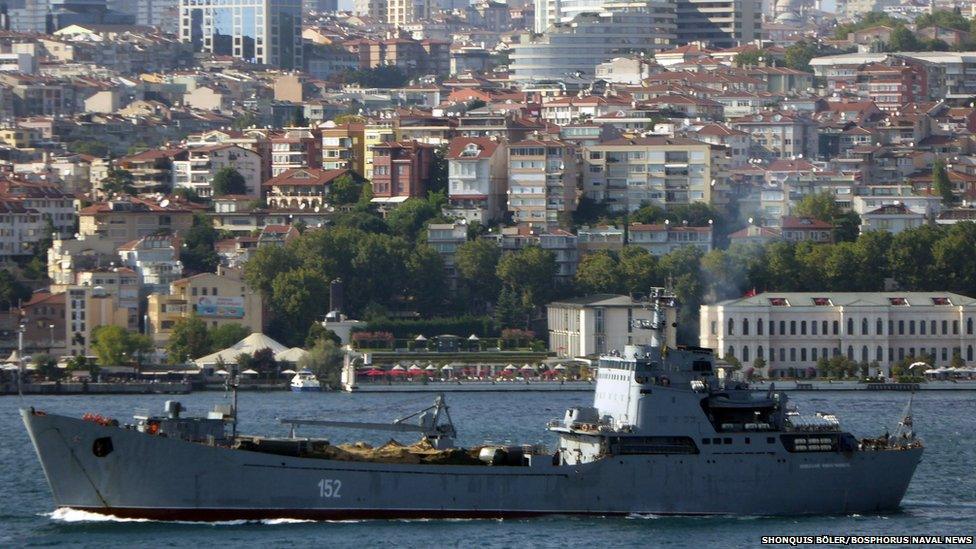Syria conflict: Russia sends signal over future role in region
- Published

The Syrian army has released images that appear to show new Russian military vehicles
Despite Russian denials that anything unusual is going on, the evidence is building of a significant Russian logistical effort in Syria to back the Assad regime.
The airfield at Latakia in north-western Syria is the focus of the Russian effort.
Several heavy Antonov military transport aircraft have arrived there over recent days and two landing ships carrying vehicles and other equipment have docked at the port of Tartus where Russia maintains a small naval base.
Moscow insists on the one hand that it is supplying "humanitarian aid" to Syria; though equally it also admits that it is continuing its long-standing policy of arming President Bashar al-Assad's forces. And where Russian equipment goes, so too do Russian advisers and trainers.
But what is going on suggests activity of an altogether different scale.
In the contemporary world there is a range of "open-source" intelligence assets that help to betray the growing Russian presence. Civil satellite images, for example, show extensive expansion and re-building at the Latakia air base with the runway being widened along its length; new accommodation; a new control tower; and lots of new concrete hard-standing.

A Russian landing ship has been seen sailing through the Bosphorus
Concrete is one of the more prosaic elements of military power but if you want to send aircraft to a location in large numbers and quickly, what you need is a surface on which they can be turned round, refuelled and sent on their way.
Landing ships carrying equipment to Syria have been spotted going through the narrow straits of the Bosphorus. YouTube images shows armoured fighting vehicles of types never before sold to the Syrians "in action" inside Syria.
Most bizarre of all in terms of operational security, "selfie" photos taken by Russian service personnel in Syria betray not just their presence but give some indication of the units from which they are drawn.
So that is what can be seen without the resources of a major intelligence service. But clearly Russia's activities have prompted a good deal of interest from the Americans.
Classic 'air bridge'
US spokesmen have urged the Russians to scale back their support for Mr Assad. And since these pleas have fallen on deaf ears, US officials are becoming rather less reticent on commenting on what they have seen of Russian activities on the ground.
So US sources are widely quoted as describing the presence of small numbers of Russian T-90 tanks in Syria, heavy artillery and mobile SA-22 air defences, though none of this has been independently verified.
That something of a Russian build-up is under way is not in doubt.
Russia is building its capabilities in Syria, but to what end? What is the purpose of all of this?
Determining President Vladimir Putin's intentions is no easy matter. What is clear though is that the scale of the Russian effort so far is insufficient to change the balance of forces on the ground.
Even if the additional equipment were all to be passed to the Syrian Army it might only give them a local advantage.

Russia's President Putin has been a key ally of Bashar al-Assad's government
What is going on is more subtle and, for now, as much a signal as a demonstration of practical intent.
Russia is putting into place all of the elements to be able to operate a classic "air bridge" - establishing a secure base in Syria with the capacity to handle enough aircraft to allow for the rapid reinforcement of the Assad regime if needed.
Once established, such a base could perform other functions. There has been speculation that Moscow might at some stage want to deploy ground attack aircraft of its own. Russian troops - though many experts believe this is unlikely - might need to become directly engaged in the fighting. A secure airport at Latakia opens up a range of options.
More important still is the signal this all sends about Moscow's foreign policy ambitions and the role that it intends to play in Syria and the wider region. There was a time after the end of the Cold War when Russia's moribund navy never ventured into the Mediterranean and its foreign policy ambitions were greatly curtailed.

Syria has taken delivery of Russian BTR-80 vehicles (foreground)
Today Mr Putin sees a much more expansive role for Russia and he sees his toehold in Syria on the coast at Tartus as providing the basis for a more significant foothold in the region.
Russia's backing for Mr Assad should be seen not as a vote of confidence in Syria's embattled president but as an investment in a country where Russia believes it can play out its foreign policy role.
Indeed, Mr Putin's military deployments signal that he will not let the Assad regime fall. This does not mean Mr Assad will be there forever. Russian diplomacy is working in tandem with its military policy exploring all avenues for reaching some sort of interim deal in which Mr Assad might stay on for at least the time being.
But Russia's horizons in Syria probably extend well beyond Mr Assad's active presence - a reflection of Russia's concerns about militant Islam and wider trends in the region and also its belief that western remedies in the Middle East have been an unmitigated disaster.
Russia's military deployments do though present some practical problems for the West, not least for Washington which has an active air campaign under way in Syrian air space.
What happens if Russia does begin to play a direct military role? Who will it be fighting - so-called Islamic State or all of Mr Assad's enemies, some of whom at least are allies of the West?
Up to now Syrian government forces have not tried to interfere with the US-led air campaign. But what problems might the presence of Russian-manned air defences lead to? Syria's grim and multifaceted civil war is just about to get a whole lot more complicated.